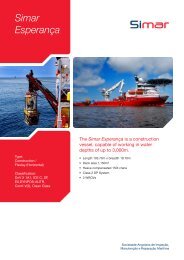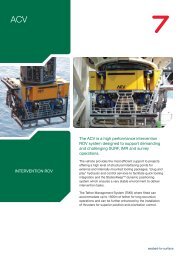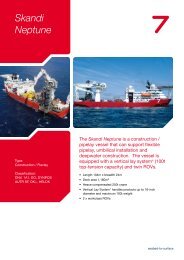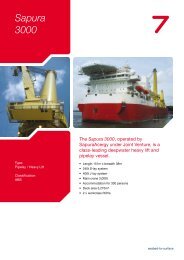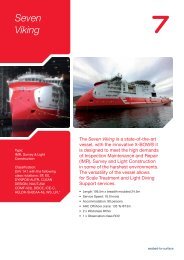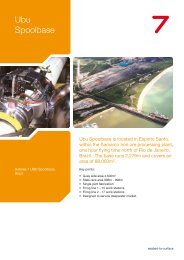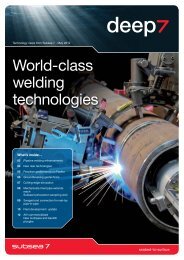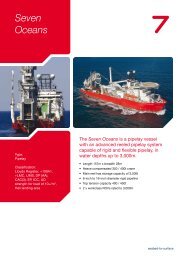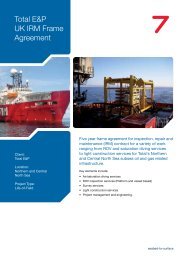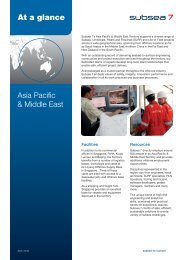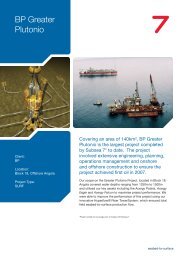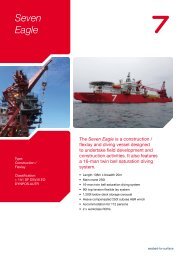Deep 7 - May 2013 - Subsea 7
Deep 7 - May 2013 - Subsea 7
Deep 7 - May 2013 - Subsea 7
You also want an ePaper? Increase the reach of your titles
YUMPU automatically turns print PDFs into web optimized ePapers that Google loves.
10<br />
Bundle technology:<br />
the next generation<br />
Sam Watt, Senior Development Engineer<br />
For over 30 years, <strong>Subsea</strong> 7<br />
has been designing, fabricating<br />
and installing Bundles (towed<br />
pipeline production systems)<br />
from our fabrication facilities at<br />
Wick, in the North of Scotland.<br />
With over 70 Bundles installed<br />
to date, this concept is a<br />
well-established and attractive<br />
alternative to individually laid<br />
flowlines in the development of<br />
difficult fields.<br />
The concept<br />
A flowline Bundle consists<br />
of a carrier pipe within which<br />
a combination of individual<br />
flowlines and umbilical<br />
components are housed,<br />
terminating in towhead structures<br />
at each end, which can include<br />
elements required for subsea<br />
production, such as valves and<br />
controls.<br />
By filling the carrier pipe and<br />
towhead tubular sections with nitrogen<br />
and attaching ballast chain at regular<br />
intervals along the Bundle, the<br />
submerged weight is trimmed to enable<br />
the Bundle to be towed at a controlled<br />
depth. This towed production system<br />
also eliminates the requirement for<br />
heavy-lift vessels.<br />
The advantages<br />
Longer tie-back distances, greater fluid<br />
temperatures and pressures, heavier<br />
and more corrosive fluids, deeper water<br />
and harsher environmental conditions<br />
are all technological challenges which<br />
can be met by Bundle technology:<br />
• BUTTING’s BuBi ® CRA-lined pipe<br />
offers significant cost savings<br />
compared to metallurgically clad or<br />
solid CRA linepipe.<br />
• Highly efficient insulation systems<br />
and active hot water-heated or<br />
Electrically Trace Heated Bundles<br />
allow longer tie-back distances and<br />
development of fields with heavier<br />
fluid compositions.<br />
• Bundle systems are considered the<br />
optimum design for HP/HT fields as<br />
DEEP7 <strong>May</strong> <strong>2013</strong><br />
56-inch Bundle carrier pipe<br />
the design permits flowline expansion<br />
along its entire length, reducing<br />
build-up of axial forces and the<br />
susceptibility to upheaval buckling.<br />
At present, the highest design<br />
temperature for a Bundle system is<br />
160°C.<br />
• There is a significantly reduced soils<br />
risk with Bundles with no individual<br />
pipelines to trench and bury, reducing<br />
project CAPEX uncertainty.<br />
• Much of the subsea infrastructure can<br />
be pre-commissioned and tested as<br />
an integrated system while onshore.<br />
• Bundles can usually be installed<br />
nearby or pulled under existing<br />
platforms, drill rigs or other offshore<br />
installations.<br />
• There is generally no requirement for<br />
heavy lift vessels as subsea structures<br />
can be incorporated within the<br />
Bundle system. The heaviest towhead<br />
structure installed to date weighed<br />
approximately 525t, for Total’s Jura<br />
project.<br />
For further information contact<br />
Sam.Watt@subsea7.com<br />
The next generation<br />
• Advances in Bundle design<br />
and analysis can further<br />
advance its suitability to HP/<br />
HT developments. Flowline<br />
pre-tensioning is one potential<br />
enhancement, where the Bundle<br />
fabrication is designed to ‘lock-in’<br />
tension within the inner flowlines,<br />
reducing the propensity to<br />
expand under temperature and<br />
pressure.<br />
• <strong>Deep</strong>er water is a challenge for<br />
Bundle design, since it places<br />
considerable demands on the<br />
collapse resistance of the carrier<br />
pipe and the internal nitrogen<br />
pressures. The greatest water<br />
depth for a Bundle design to<br />
date is 410m, for BG’s Knarr<br />
development, but it is expected<br />
that this can be extended in the<br />
future by the use of alternative<br />
buoyancy arrangements.<br />
• The length limit for a single<br />
Bundle at our Wick facility is<br />
approximately 7,600m; for longer<br />
tie-back distances, multiple<br />
Bundles connected in series are<br />
required. BP’s Andrew project<br />
in the North Sea utilised four<br />
Bundles to span a distance of<br />
27.8km. Options are currently<br />
being considered to increase the<br />
maximum achievable length of a<br />
single Bundle.<br />
• The largest carrier pipe diameter<br />
specified for a project is currently<br />
56-inches, for Total’s West<br />
Franklin development. The<br />
launchway is expected to cope<br />
with carrier pipes up to 60-inches<br />
in size.<br />
• The application of Bundles<br />
in far north fields is currently<br />
being considered, with a study<br />
assessing the feasibility of<br />
installing a Bundle in the Barents<br />
Sea, approximately 2,000km<br />
from Wick, where soil conditions<br />
are extremely challenging due to<br />
historic iceberg scarring.<br />
• Health monitoring systems are<br />
becoming available which allow<br />
corrosion, erosion, blockages and<br />
leaks to be monitored in real-time.<br />
Incorporating these systems into<br />
Bundles will enhance <strong>Subsea</strong> 7’s<br />
Life-of-Field capabilities.<br />
We believe that <strong>Subsea</strong> 7’s Bundle<br />
technology will continue to play a<br />
key role, both in the North Sea and<br />
progressively further afield.



